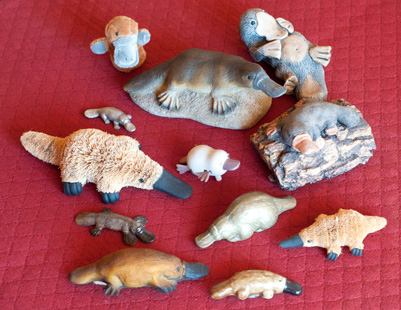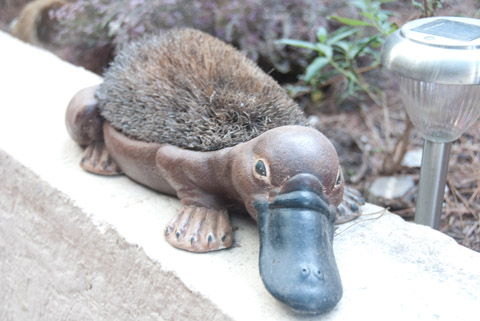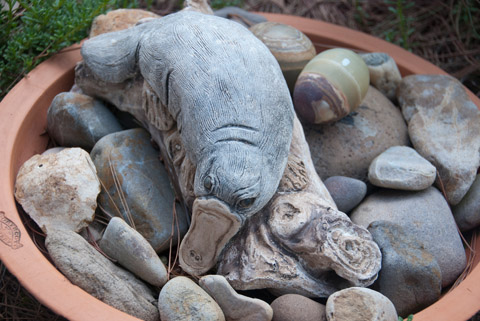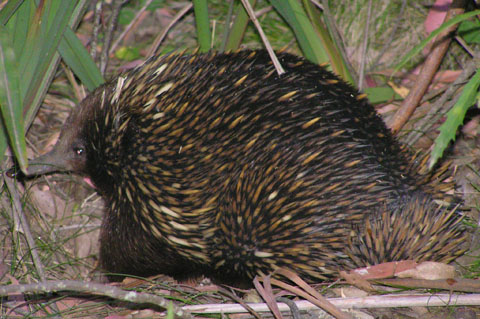![]() The Case of the Missing Monotremes*
The Case of the Missing Monotremes*
 Some years ago, when we bought our little country cottage, we discovered at least two platypuses visiting our stretch of the creek. As a house-warming present, my husband bought me a stone platypus he’d found in the local nursery. In turn, I gave him a duck-billed doorstop. Soon I had acquired a vast collection of platypuses, indoor and out: stuffed toys, glass, silver, pewter, ceramic and china ornaments, a thimble, a bottle stopper, Christmas decorations, fridge magnets, coasters, mugs, plates, prints – you name it, we had it. Some of them were my own purchases; others were gifts from visiting family and friends. A ten-year-old house guest was so fascinated by the collection that she actually counted them and came up with a total of thirty-eight. And that was just inside! Then she gave every single one its own name.
Some years ago, when we bought our little country cottage, we discovered at least two platypuses visiting our stretch of the creek. As a house-warming present, my husband bought me a stone platypus he’d found in the local nursery. In turn, I gave him a duck-billed doorstop. Soon I had acquired a vast collection of platypuses, indoor and out: stuffed toys, glass, silver, pewter, ceramic and china ornaments, a thimble, a bottle stopper, Christmas decorations, fridge magnets, coasters, mugs, plates, prints – you name it, we had it. Some of them were my own purchases; others were gifts from visiting family and friends. A ten-year-old house guest was so fascinated by the collection that she actually counted them and came up with a total of thirty-eight. And that was just inside! Then she gave every single one its own name.
Now let me tell you a story about the platypuses in my garden. One night we arrived late at our cottage after a long drive from the city. As I walked along the path leading to the front door, I had a feeling something was different. My husband shone his torch around, but everything seemed to be okay. It wasn’t until the next morning when I was hosing the garden that I noticed the resin platypus which normally resides in the bird bath, was no longer there. Curious. Then I looked for the doorstop platypus. You guessed it. He was gone too. So was a large monotreme made of stone, measuring at least twice the size of the real animal. (I had discovered him at the local markets. He was so heavy I could barely lift him. In the end I had to phone my husband to come and lug him back to the car.) A couple of smaller platypuses had gone missing as well. Then I checked my other garden ornaments – a wooden birdhouse, several birdbaths, a stone wombat, a weather vane, a selection of ceramic pots. Not to mention a French-style metal table and chairs. Everything was in its place, except for the platypuses. Curiouser and curiouser.
After considering the items which had been taken, and those left behind, together with the fact that the incident had taken place during the school holidays, we came to the conclusion that the culprits were children. But how could a child have carried that big platypus home? It would have taken at least three children to haul him any distance, and surely someone would have seen them doing it.
So where had those platypuses gone? In my imagination I pictured them gracing someone else’s garden. And whenever I went for a stroll, I peered over front fences, looking for my animals. Then I realised that no thief in their right mind, even a childish one, would display them openly. And no parent worth his or her salt would fail to ask questions about a collection of stone platypuses that had suddenly appeared in their garden.
It took me a long time to recover from the loss of my monotremes. In fact, I remained outraged for weeks. So much so that I even considered penning a letter to the local newspaper, warning about petty crimes being the predictor of future criminality and advocating zero tolerance in these so-called ‘minor’ matters. Although I drafted the letter on my laptop, for some reason I never actually sent it.
 Over the next few months I set about replacing the absent animals. But even when a replacement looked like the original, it lacked the sentimental value. For a long time I felt sad. Not just because my platypuses were gone, but because I was heartsick at the thought of children blithely stealing someone else’s property.
Over the next few months I set about replacing the absent animals. But even when a replacement looked like the original, it lacked the sentimental value. For a long time I felt sad. Not just because my platypuses were gone, but because I was heartsick at the thought of children blithely stealing someone else’s property.
When spring arrived, my husband decided to do some tidying in the wild part of the garden where we grow native shrubs – wattles, bottlebrush and banksias, among others.
‘I’ve found your platypuses!’ he shouted. ‘Come out and have a look.’
As he’s a person renowned for kidding others, I thought he was just winding me up and so I ignored him and continued working at my laptop.
‘It’s true,’ he called out. ‘They’re all here. Under a bush.’
I dragged myself away from the manuscript I was working on, put on my shoes and went outside. There, under a banksia bush and half hidden in a layer of leaf mulch, was a circle of platypuses. They hadn’t been stolen after all! They’d been living at ‘Platypus Glen’ the entire time. Whether children had moved them there, or they had somehow migrated by magic, I didn’t know. But whatever had happened, they looked quite content in their hiding place. So content they might have been having a tea party. The big, heavy platypus was there too. Only a few metres from his former home.
Since I had already replaced each and every one of them with new versions, I decided to leave the ‘Originals’ where they were, enjoying each other’s company in the shade of the banksia. A circle of friends. It’s odd really. Because platypuses are known as solitary creatures. But not my monotremes – they like a party!
*Monotremes are egg-laying mammals. There are only two kinds of monotreme in the world – the echidna (spiny anteater) and the platypus, and both are native to Australia. You can see pictures we’ve taken of these fascinating creatures in the slideshows.

Deborah O'Brien
June 2012
